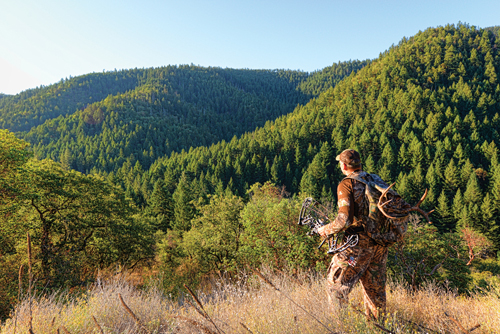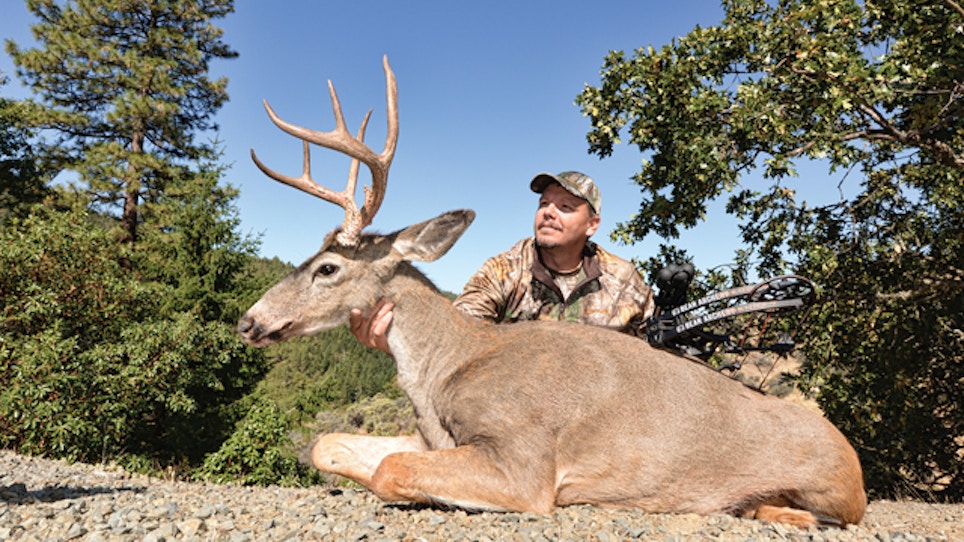My heart rate was elevated because of the dozen or so does that had already filtered through my setup, and as I watched the last ounce of evening light drain below the western horizon, I knew a buck could appear at any moment.
Nicknamed the ghost of the Pacific Northwest, Columbian blacktails are known to be creatures of the night, especially during the early season, and with temperatures hovering in the mid- to high 80s and ultra-dry conditions still blanketing this scenic chunk of southwest Oregon, I had no doubt that releasing a carbon arrow was going to be a last-light affair.
Even though I was inexperienced when it came to chasing the Columbian blacktail, the location I was planted in was obviously an ideal spot to bloody an arrow. It was a foothills meadow about half the size of a football field with a water source close by. Located between the higher north-facing bedding areas, lush hay fields and orchards in the lower valley, it was the perfect stop-over location for blacktails to cruise through as they headed toward the lower feeding areas, and I hoped one would slip through during these last moments of legal light.
I looked at my watch one more time as the seconds seemed to tick by at breakneck speed, but when I looked up, movement coming from a brushy hillside caused me to grip my bow a little tighter. With visions of mature blacktail bucks dancing through my mind throughout the afternoon, I was sure it was a buck; a quick view through my bright binoculars erased any doubts I may have had. I knew the buck. The outfitter had shown me a trail camera picture of him, and though he would miss the Pope & Young record book, his heavy 6-point frame would no doubt put a huge smile on the face of this novice blacktail bowhunter.
Like a military sentry looking over his battleground, the buck’s head turned from side to side searching for foes. When his senses convinced him that all was clear, he cautiously proceeded in my direction. With each step my heart thumped harder, and just when I was about to press my finely tuned Bear Agenda bow into service, he suddenly paused and looked directly toward my elevated perch. I froze like a statue hoping to overcome his suspicions, but even his young eyes knew something was up. As quickly as he appeared he vanished back into the woods, reinforcing the blacktail’s ghostly reputation I had read and heard so much about. I knew at that moment that I would forever be fond of the Columbian blacktail.
The Elusive Blacktail
There are two subspecies of blacktails in North America: the Sitka blacktail, which roams the coastal rainforest of Southeast Alaska and the northern coastline of British Columbia, and the more common Columbian blacktail, which can be found along the Pacific coastal mountain region and into the Cascade Mountain Range from California to British Columbia. Typically smaller in body than their whitetail and mule deer cousins, a Sitka blacktail buck usually weighs about 125 pounds, and the Columbian blacktail is slightly heavier at around 150 pounds.
Antler size is also smaller. A Columbian blacktail typical rack must measure 95 inches and a non-typical rack only 20 inches more. The Sitka blacktail P&Y minimum is just 75 inches. In the Boone & Crockett tradition, a typical Columbian blacktail must measure 135 inches to make the all-time record book and a non-typical must stretch the tape 155 inches. The typical Sitka blacktail comes in even smaller at 108 inches, and 118 to hit the non-typical mark.
Although Columbian blacktails tend to have a mule-deer-like appearance, it’s their whitetail-like behavioral characteristics that can make them the ideal western challenge. First off, mature bucks rarely make an appearance during daylight hours once they shed their velvet. This usually occurs in late August to early September, and once their horns begin to harden, they start parting ways from their summer bachelor groups and begin to prepare for the rut. Secondly, they love thick cover, which provides cooling protection from the sun and annoying biting flies and gnats.
A Bucket-List Bowhunt
 Doug Gattis of Southern Oregon Game Busters has been outfitting in southwest Oregon’s Applegate Valley for 25 years. Not only is Doug a well-known blacktail and black bear outfitter in the Medford area, but the Applegate Valley is one of Oregon’s top trophy-producing regions. When friend and hunting consultant Wade Derby of Crosshair Consulting told me Doug had an early-season opening, it was a bucket-list bowhunting experience I couldn’t refuse.
Doug Gattis of Southern Oregon Game Busters has been outfitting in southwest Oregon’s Applegate Valley for 25 years. Not only is Doug a well-known blacktail and black bear outfitter in the Medford area, but the Applegate Valley is one of Oregon’s top trophy-producing regions. When friend and hunting consultant Wade Derby of Crosshair Consulting told me Doug had an early-season opening, it was a bucket-list bowhunting experience I couldn’t refuse.
Like any quality outfitter, Doug had been monitoring several P&Y candidates much of the summer. He had numerous well-placed trail cameras in travel corridors and feeding locations. Doug only takes a handful of hunters throughout the season, so he’s able to control the number of bucks being harvested on the land he hunts and make sure only mature bucks end up with a tag wrapped around their horn.
My experience on day one of the hunt had taught me that morning traffic tended to be pretty slow, but as the day pressed on, more deer would expose themselves. Although most of them were does and young bucks, trail camera photos revealed an impressive 5x4 and heavy 4x4 making an occasional daytime visit. When the fourth day arrived, I elected, as I had done the three previous days on stand, to sit most of the day. I knew my chances of seeing one of the bucks in the middle of the day were slim, especially since both had recently shed their velvet, but with only five days to hunt I didn’t want to miss an opportunity.
With 30 minutes of light left, deer started to seep from the woods around me. Does were the first to appear, and sure enough, a couple young bucks followed. I watched them feed in the meadow under the fading light until, one by one, their attention was drawn to a thick patch of timber below them. It was obvious something was about to step out. I studied the area with my light-grabbing optics, looking through every opening to see what it was. Just when I thought the deer’s alertness was possibly a blacktail’s skittish ruse, I saw a hint of antler break through the timber.
Once he completely broke through the tangle of brush I could clearly see it was the heavy 4x4. As he walked onto the meadow his grayish body dwarfed the other deer around him, and, like kids encountering a bully on a playground, the smaller bucks eased out of his way. He was on high alert as he strolled through the meadow, and when he slipped behind a tall pine I pressed my bow into service. In an instant, my broadhead-tipped arrow blew through his chest with an echoing whack, and the buck’s immediate up-ended reaction told me it was a solid hit.
His tall and heavy 4x4 rack was impressive in my calloused hands, and his oversized body was bigger than I originally thought. As I stroked his handsome coat and reminisced on the past few days, I knew that this would not be the last time I would chase the ghost of the Pacific Northwest.
Outfitter Notes
Doug Gattis, or “Mr. Blacktail” as I like to call him, has been chasing blacktails in his home state of Oregon and northern California for over 50 years. He killed his first blacktail, a dandy 3x3, at the age of 15. With over 80 blacktail bucks to his credit, 15 of which meet the 135-inch B&C minimum, and countless other bucks he has guided hunters to, Doug has forgotten more about blacktail hunting than most of us will ever know.
Doug has hunted virtually every deer in North America, and like many who regularly chase blacktails in the Northwest, he feels that they are, without question, the toughest deer species to hunt. Doug insists bowhunters can stack the odds in their favor with a little hard work, capitalizing on subtle changes that take place during the hunting season and paying attention to the little details.
For the early-season bowhunter, scouting can pay huge dividends those first few days of the season. Finding where bucks spend the summer, locating what foods and water sources they prefer and where they bed are all critical to early-season success. Doug says glassing open meadow edges, grassy hillsides, recently logged areas, wild berries, agricultural fields and orchards is a great way to locate buck activity. July and August are good times to see bucks feeding during the afternoon hours and even bedding in the open in an effort to keep the thick brush from damaging their velvet antlers.
Bowhunting during poor weather can also better your chances of slipping an arrow through the chest of an old buck, regardless of the time of season. In fact, the more miserable the better, insists Doug. Cold, misty, foggy days bring blacktails to their feet, and although these conditions can be miserable, Doug believes they are ideal.
“Hands down, the best time to hunt blacktails is during the rut,” said Doug. “If you can get some misty cold weather mixed in with it, you’ll think you’ve gone to blacktail heaven.” During this time mature blacktail bucks search far and wide to breed, and bucks you have never seen before suddenly show up. Rattling can work extremely well, as can buck grunts, but Doug has found fawn bleats tend to work the best. Blacktails are very territorial, so hunting near scrape lines can also provide an opportunity. “Key areas to focus on would be natural travel corridors like saddles, ridges, trail hubs and where several drainages come together,” Doug said.
His number one tip: Doug says hunter endurance is the key to successfully killing a mature blacktail. Sitting long hours on stand regardless of the weather is the best way to tag a trophy blacktail.
For more information or to book a hunt with Doug, visit his website at www.blacktails.netor call (541) 770-5050.






